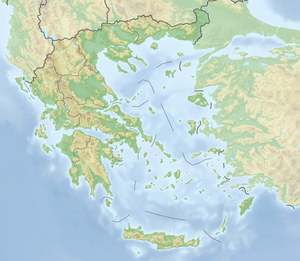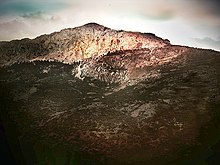Parnassus
| Parnassus | ||
|---|---|---|
|
Parnassus |
||
| height | 2455 m | |
| location | Greece | |
| Coordinates | 38 ° 32 '6 " N , 22 ° 37' 20" E | |
|
|
||
The Parnassus ( modern Greek Παρνασσός Parnassós , Latin Parnasos, Parnasus, Parnassos, Parnassus (m.)) Is a 2455 meter high mountain range in central Greece . Delphi lies at the southwestern foot of the massif . It offers a picturesque panoramic view of olive groves. In Greek mythology , Mount Apollo is consecrated and the home of the Muses , the goddesses of the arts. That is why the Parnassus is considered in a figurative sense as a symbol and epitome of poetry or art.
The mountain was referred to as 'two-peaked' in ancient times. Apollo wounded the snake python here . After the flood , Deucalion and Pyrrha landed on Parnassus.
Today the mountain is a well-known ski area.
The Montparnasse in Paris is named after Mount Parnassos .
Mountain peaks
The highest peak of the mountain range is Liakoura (Λιάκουρα) with 2455 meters.
Other peaks are:
- Tsárkos (Τσάρκος), 2415 m
- Jerontóvrachos (Γεροντόβραχος), 2395 m
- Kalójiros (Καλόγηρος), 2327 m
- Mávra Lithária (Μαύρα Λιθάρια), 2326 m
- Voidomáti (Βοϊδομάτι), 1947 m
- Petrítis (Πετρίτης), 1923 m
- Pyrgákia (Πυργάκια), 1718 m
The Parnassus as a symbol in art
Up until the 18th century in particular, but also beyond, the Parnassus was a frequently used subject in the visual arts and a symbol for art, music and literature as the seat of the god Apollo and the muses.


Painting:
- Parnassus (Raffael) : a fresco by Raphael (1511) in the "Stanza della Segnatura", where the better known work The School of Athens can be found
- Apollo and the Muses on Parnassus by Nicolas Poussin
- The Parnassus , painting by Anton Raphael Mengs
In the 20th century:
- Ad Parnassum , painting by Paul Klee
Sculpture:
- The Parnassbrunnen in the Calenberger Neustadt in Hanover, for which Hieronymo Sartorio delivered the model in 1671 ;
Garden architecture:
- Parnassus , an artificial rock with bases for the statues of Apollo and the Muses in the Hermitage (Bayreuth) from the early 18th century.
- The Musenberg Parnassus , in the rococo garden Veitshöchheim , created in 1765 by Ferdinand Tietz. An artificial rock with statues of Apollo, the Muses and the winged Pegasus, built in the middle of the great lake.
Music:
- An influential textbook on music theory in the 18th century by the Viennese court music director and composer Johann Joseph Fux is entitled Gradus ad Parnassum (“Step to Parnassus” or “Way to the Summit”). The textbook of counterpoint in the figurative sense means a significant artistic advance or the step of the composer towards perfection. Famous compositions of world renown are referred to as “summit work”.
- The piano pedagogue and composer Muzio Clementi published his well-known etude work in 1826, also with the title Gradus ad Parnassum op. 44, which consists of piano pieces of increasing difficulty.
- In Richard Wagner's Mastersingers , Walther von Stolzing praises the "Muses of Parnassus" several times in his award song:
- The first piece from Claude Debussy's piano suite Children's Corner (1908) is entitled Doctor Gradus ad Parnassum , which jokingly refers to the previous works in music history.
Literature:
- Parnassus plays : Three plays ( Renaissance dramas ) published anonymously between 1598 and 1602: The Pilgrimage to Parnassus , The First Part of the Return from Parnassus and The Second Part of the Return from Parnassus . They were performed at St John's College , Cambridge for Christmas.
- El Parnasso Español, monte en dos cumbres dividido, con las nueve musas castellanas . Poems by the Spanish poet Francisco de Quevedo y Villegas (1580–1645), published in 1648.
- In 1732, Évrard Titon du Tillet published a collection of names on the fame of French poets and musicians in his Parnasse françois, suivi des Remarques sur la poësie et la musique et sur l'excellence de ces deux beaux-arts avec des observations particulières sur la poësie et la musique françoise et sur nos spectacles ,
- Louis-Édme Billardon de Sauvigny published Parnasse des Dames ou choix de pièces de quelques femmes célébres en littérature in Paris in 1773 .
- Le Parnasse contemporain : A three-volume collection of poems published in France between 1866 and 1876
various
- On the Piraeus – Thessaloniki railway line there is a train station called Parnassos .
- The Alfred-Scherz-Verlag , Bern, founded in 1938, published a series of books from 1943 to 1959 under the name Parnass-Bücherei.
- The Austrian art magazine Parnass has been published since 1981 .
- Parnassius is a species-rich genus within butterflies. The Apollo butterfly (Parnassius apollo) is a well-known representative.
Web links
Individual evidence
- ^ Rainer Ertel : Parnassus fountain . In: Klaus Mlynek, Waldemar R. Röhrbein (eds.) U. a .: City Lexicon Hanover . From the beginning to the present. Schlütersche, Hannover 2009, ISBN 978-3-89993-662-9 , p. 495.
- ^ Johann Joseph Fux: Gradus ad Parnassum or an introduction to the regular musical composition . Olms, Hildesheim 2004, ISBN 3-487-05209-1 (reprint of the Leipzig 1742 edition).
- ↑ Parnassus Plays . In: Encyclopædia Britannica . 11th edition. tape 20 : Ode - Payment of Members . London 1911, p. 854 (English, full text [ Wikisource ]).
- ^ Kindler's New Literature Lexicon . Volume 13. Munich 1988, ISBN 3-463-43200-5 .
- ^ Paris, 1732 Google Books
- ↑ Parnasse des Dames , Vol. 1-10. Ruault, Paris 1773 ( first volume on google books ).
- ↑ Artists' magazine Parnass ( Memento of the original from November 6, 2012 in the Internet Archive ) Info: The archive link was automatically inserted and not yet checked. Please check the original and archive link according to the instructions and then remove this notice. , accessed March 20, 2013



